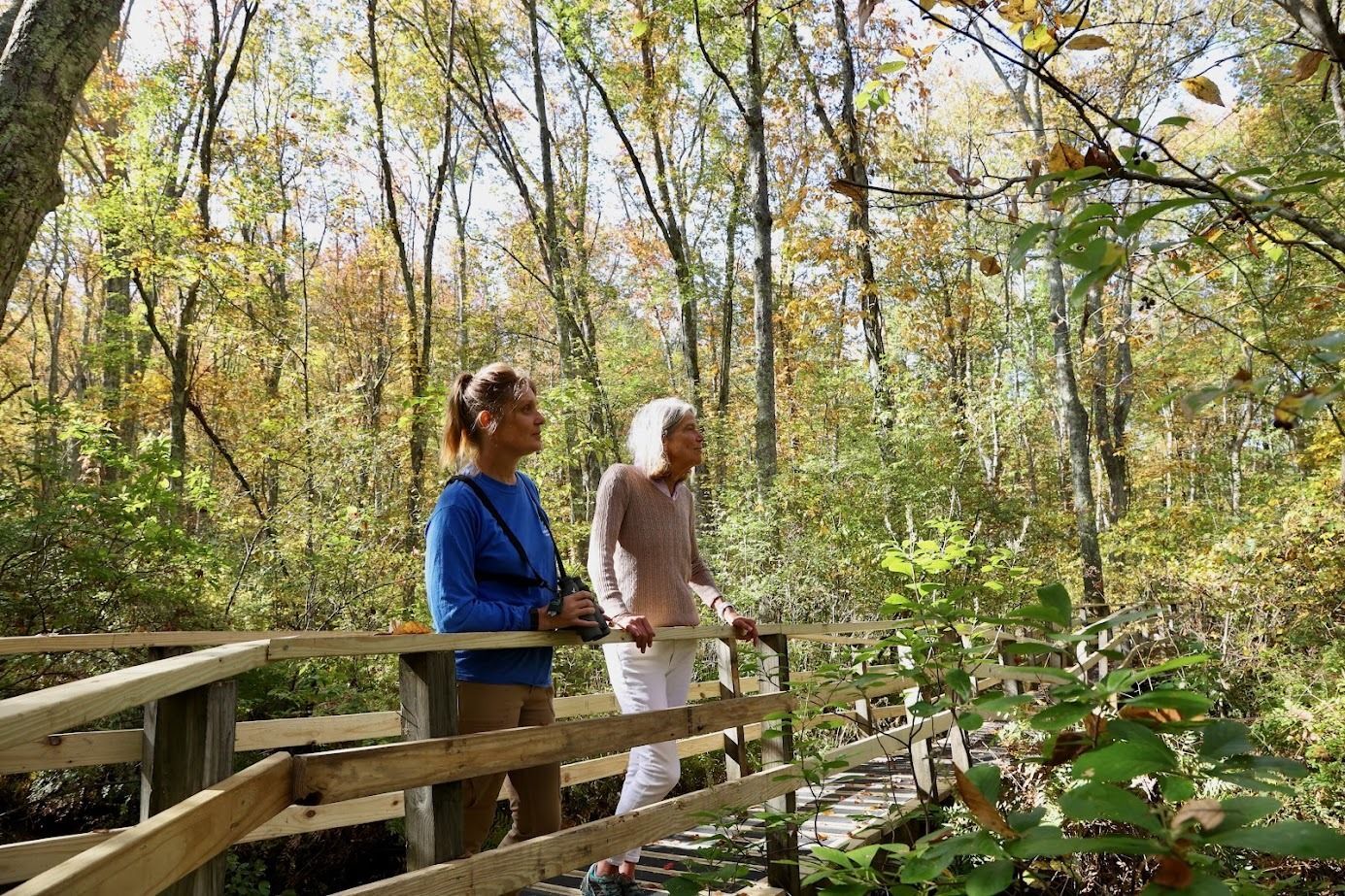
Photo by Richard Staples: Properties Director Laura Carberry (left) with Betsy Walker on the new footbridge at Parker Woodland Wildlife Refuge.
Published December 3, 2023
The Big Fix: Giving to Audubon in 2023 has had a major impact on making nature more accessible
By Betsy Sherman Walker
It is a mild, breezy day in early October, suggestive of pumpkins and foliage, and there is learning in the air. Community Education Coordinator Lisa Maloney is welcoming three classes of energetic kindergartners from the Croft School in Providence to a field trip at the Caratunk Wildlife Refuge in Seekonk, Massachusetts. The theme for the morning activity is “Sensory Safari.” Standing in front of the group in the white barn, Maloney addresses them with a blend of Sesame Street camaraderie and kindergarten-style gravitas.
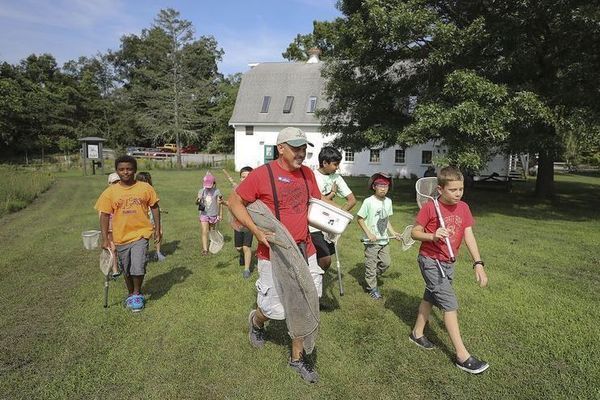
Summer campers go ponding at the Caratunk Wildlife Refuge. Photo by Glenn Osmundsonn.
Maloney explains that Caratunk is a wildlife refuge, “a place where we protect trees, plants, and animals.” She adds, “Today we’re going to do activities to test your senses and see how you compare to other animals. Senses are important to us and to animals,” she explains. “Some animals are super-hearers or super see-ers.”
Teachers, parents and children then follow Maloney outside. “We’re going to test our senses, as we walk along the trail,” she tells them. For one of the mothers there that morning, family outings to Caratunk have become a regular thing. “We didn’t know this place existed till COVID,” she told me. “We think it is a hidden treasure.”
For both Executive Director Jeff Hall and Senior Director of Education Lauren Parmelee, this is a shining example of the impact of donorship. They have a shared vision for Caratunk, which Parmelee describes as “a place near the city for kids and families to get outside and explore nature. We are looking for Caratunk to be an accessible and welcoming location for all, with a focus to reach communities in Providence, Pawtucket, and Central Falls.” A year ago, it might not have been that easy.
Sometimes the most monumental, impactful things can grow from the most unexpected beginnings—in this case, a phone call and the simplest of questions: What do you need?
Hall had just walked out of his office and was headed to the parking lot on a Friday afternoon in January 2021, when the telephone on his desk rang. He went back inside to answer it; on the other end of the line the caller introduced himself, explained that a family member, Helen Bracket, had passed away— and that in handling her estate he was in the process of exploring worthy causes. He asked the executive director, “what do you need?”
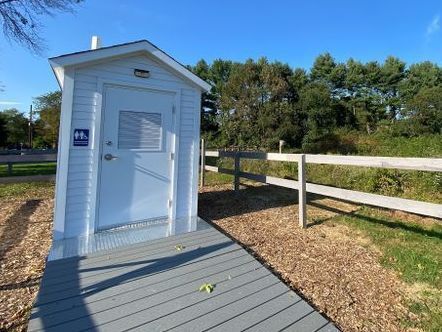
The Composting Toilet at Caratunk Wildlife Refuge installed in 2021
At the top of Hall’s mind was the Caratunk Wildlife Refuge and an expensive Clivus composting toilet. The conversation took some twists and turns, always returning to the topic of Caratunk. Hall came up with an inventory of needs—the toilet was just the tip of the iceberg. Caratunk needed updates to the teaching facilities and new student chairs and tables, outdoor exploration tools for young summer campers, picnic tables that were wheelchair accessible, transportation scholarships for children in underserved communities, and new appliances for an outdated kitchen area. He told the caller that this wildlife refuge, with its signature White Barn, had been the original education facility for nature programing at Audubon. It was still very popular with locals for hiking and provided a home for summer camps. But the facility was showing its age and had taken a hit during COVID. The desire to lavish some much-needed attention on it—with some much-needed capital—was strong. “From there,” Hall said, “the conversation led to fixing infrastructure, increasing the number of camp scholarships, lengthening the camp sessions, and more.” It basically became a conversation about how much it would cost to update Caratunk and return it to the first-rate environmental education center it had been.
“This was Jeff’s vision,” Parmelee explains, “to turn Caratunk into an accessible Nature Center, specifically for school field trips, summer camps, and year-round programs for residents of Providence and other nearby communities. The Nature Center and Aquarium in Bristol is big and inviting,” she added, “but may be hard to get to for people in other areas of the state.”
By the end of 2023, the estate of Helen Bracket, who grew up in Seekonk and worked for years with children from underserved communities, will have made gifts totaling $250,000 towards the items on Hall’s Angels List. Audubon received other substantial bequests in 2023 as well. “We’re very blessed that way,” said Hall. “People are passionate about protecting birds and nature, and they understand the importance of conservation, protecting nature for future generations.”
This could be called Audubon’s year of the Big Fix. From Caratunk to a new footbridge at the Parker Woodland Refuge in Coventry, and gravestone repairs at the Fisherville Brook Wildlife Refuge in Exeter, many of the gifts have gone towards maintenance, repairs, and upgrades. Likewise, the Nature Center in Bristol now has an expanded and more accessible pollinator garden, a newly installed state of the art MOTUS bird tracking tower—a game changer for Director of Avian Research Dr. Charles Clarkson and has received additional funding for the remarkable “Taking Root” initiative, devoted to making Audubon’s trails and programs, its birds and its bees, accessible to nature lovers of all capabilities. Bringing nature to all.
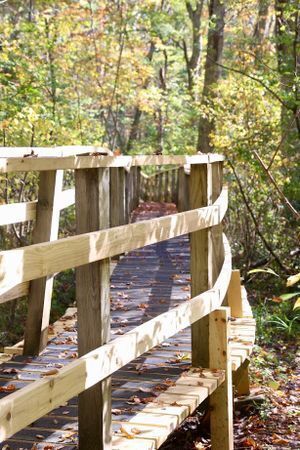
The footbridge at Parker Woodland Wildlife Refuge. Image by Richard Staples
This year we’ve been fortunate, we’ve received generous donations,” was the first thing Properties Director Laura Carberry said to me in the parking lot of the 870-acre Parker Woodland Wildlife Refuge, prior to our trail walk to get a look at the new footbridge. It was a $5,000 project, overseen by Carberry and executed by Audubon conservation staff, the Youth Conservation League, and a group of volunteers, that almost didn’t happen—until an anonymous donor came through with $4,000. The final $1,000 was a gift from the software firm Dassault Systèmes in Johnston. The bridge is sturdy, a study in rustic elegance. Handrails run its entire 156-foot length, and it is so long that from one end it actually curves and disappears into the woods. One almost expects to see a troll climbing out from underneath.
Last summer as the project was getting underway an enthusiastic Carberry emailed Hall an early update. “I just wanted to let you know the conservation crew has started to work on the Parker Woodland Bridge,” she wrote. “This is a huge project. Thank you so much for your support. Without the funding from our donors, it never would have happened. My staff is so excited to see the progress we are making,” she added. “It really shows what a great team they are.”
As we walked Carberry described her responsibilities managing Audubon’s 9,500 acres of protected properties across the state—and the challenges of priority lists when most of what is needed is so unglamorous. Infrastructure is not a particularly glamorous topic, and funding for crucial repairs and updates are often the hardest to come by.
Hall would agree. “Our refuges are constantly changing. Forests and fields are growing, weather can create challenges, and limbs fall and block trails,” he says. “When we don’t have the resources, projects get sidelined. We exist because people want nature,” says Hall. But, he adds, “people tend to think, ‘nature’s free.’”
Carberry, who stepped into the Director of Properties position last April, spoke passionately of “the importance of having access to trails and preserving our forests” and explained that “every Audubon wildlife refuge is really unique in the habitat and wildlife it protects.” Her job is to keep them open, safe, accessible, and inviting. To do this she relies on a small army of volunteers—trail monitors and troubleshooters. Tuesdays are Conservation Days. Audubon staff, TerraCorps service members and volunteers all meet to discuss repairs and, if necessary, select a project to team up on. The work can include conservation projects, repairs and maintenance needs on our many wildlife refuges. “Volunteerism is philanthropy as well,” Hall tells me.
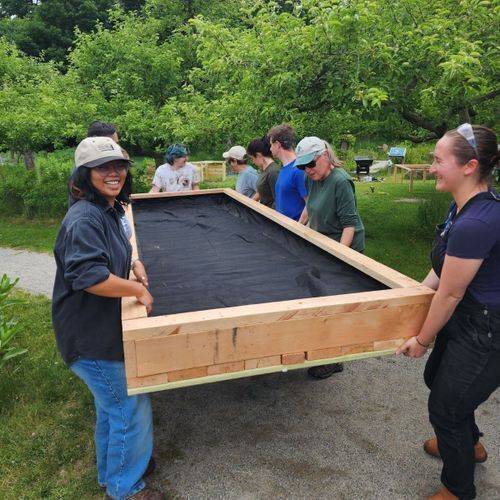
DownCity Design installing the raised garden bed. Photo by Dan Mitrovic.
Former Audubon Board Member and Master Gardener Terry Meyer also understands the impact of volunteerism. She recalled that in 2018, the Palmieri Pollinator Garden in Bristol came together when Audubon received funding from the Vivian J. Palmieri Trust for a memorial garden. Around the same time, renowned landscape architect John Gwynne approached Audubon with a vision for a garden that would demonstrate to the public how to “rewild” suburban landscapes. According to Garden Coordinator Katie Schortmann, “a little patch of land in Bristol” was turned into a stunning pollinator garden filled with native plants and wildlife habitat. Meyer volunteered to work with Gwynne and she brought together a team of URI Master Gardeners. Soon, she and Nick Califano – a fellow board member and master gardener - were coordinating teams of volunteers.
This year, Audubon was approached by the Providence youth organization DownCity Design, proposing a project for middle school students to create and install an all-access raised garden bed. “The results made gardening infinitely more accessible to staff and visitors,” says Schortmann. The new bed was designed to be accessible for children and those who use a wheelchair or might want to sit while gardening.
A bumper crop of plants has been donated by Meyer over the years, she has funded educational pollinator signage and been instrumental in supporting the upcoming symposium in April 2024 on “Transforming the Landscape.” Like Meyer, most garden volunteers are passionate about their work and return year after year to ensure that the garden remains a thriving habitat for pollinators - and a place for visitors to learn about wildlife.
Mary Ann Cofrin has also been an active supporter of reestablishing native habitat for pollinators and has funded critical work on Audubon wildlife refuges across the state to support healthy pollinator populations. Just this past summer she was instrumental in providing funds for an Audubon intern to work on public outreach and complete research on native bee populations.
Cofrin has been an Audubon supporter since 2018, when she made a donation and Hall subsequently gave her a call. Their conversation has continued for years. As a donor, Cofrin is more apt to wait for a cue about what is needed, do her own research on the topic, and then respond with abundant generosity. “The need may be something that wouldn’t necessarily be on my radar,” she says. “But it can be very important, so I listen carefully to what the current needs are.” Her reach extends throughout the organization.
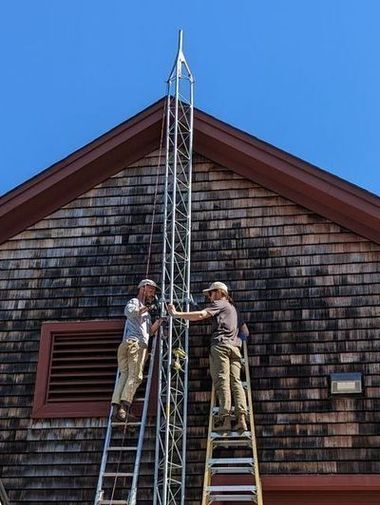
MOTUS Tower Installation at the Audubon Nature Center and Aquarium in Bristol, RI
This year, Cofrin indeed listened, and as a result the MOTUS tower was installed last April in Bristol as part of the Audubon Avian Research Initiative. At first, she was skeptical. “I heard they were thinking about installing a tower,” and I thought, ‘Oh no, a tower?” She was imagining something as large as a cell-phone tower. Cofrin quickly got up to speed and realized how small, in reality, the tower was. (According to Clarkson, about the size of a rooftop TV antenna.) Cofrin then learned that birds would have to be tagged in order to be detected, which also left her a little wary. “I came to understand the disturbance to the birds is minimal, and the importance of all the data tracking will be enormously beneficial in the long run.” It’s important and Cofrin was all in. MOTUS (Latin for “movement”) towers are located across the globe, with over 30 countries participating in data collection. “Rhode Island is a main artery for migratory birds in the Northeast,” Cofrin added “and the East Bay was one place that was missing a tower.”
Just six months in, Clarkson says the MOTUS tower has dramatically upped Audubon’s game in the study of birds and how they are faring in a rapidly—scarily—changing environment. “Migration is always a big question, and we are slowly figuring out their paths and survivorship. At the end of the day,” he adds, “it is still the biggest unexplained phenomenon in ornithology.” The tower, he says, gives us a little peek under the hood. “The more we learn, the better equipped we are.” And Cofrin, an avid birder and nature photographer, understands how critical this work is.
Cofrin says she has “always liked projects that are off the beaten path. And, Audubon itself is a bit off the beaten path.” Similarly, she was drawn to the Taking Root initiative and Audubon’s work with the Dr. Martin Luther King, Jr. Community Center in Newport because “those needs resonated. When I need [a recharge] I go outside. I walk in the woods, I hear the birds sing. Imagine the difficulty,” she adds, “for people who can’t do that, who do not have access to the outdoors. Everyone should be able to experience those benefits.”
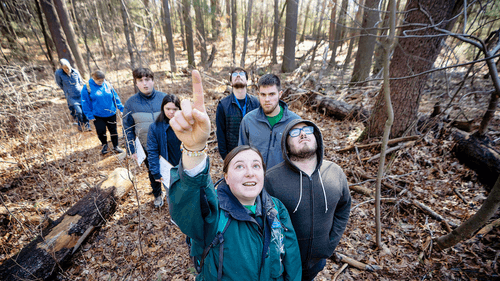
Audubon Educator Kate Swain with Cumberland High School’s special education program exploring Powder Mill Ledges Wildlife Refuge as part of the Taking Root Initiative.
Kate Swain is the Audubon educator who, using her Master’s Degree in Special Education, was instrumental last year in launching Taking Root. She says that Cofrin’s support is evident in almost every aspect of her work and has funded a variety of needs from transportation and program scholarships that bring students to the wildlife refuges to updated educational materials. This fall she has been working with second- to fourth-graders enrolled in the special education program from the Chariho School District. They meet once a month at the Fisherville Brook Wildlife Refuge in Exeter for a nature walk. “The students did really well in that setting,” she says. They relax, they learn, and enjoy themselves. At the end of the first trip a boy who was visibly anxious about being outside with “ticks and other insects, made a point of telling me that he had a great time.”
Likewise, Audubon has teamed with the Dr. Martin Luther King, Jr. Community Center in Newport for a number of years, offering after-school outdoor explorations, summer camp programs, and story-time sessions that introduce nature (and cool animals) to preschool students. “It’s all about getting kids interested in and excited about nature,” said Parmelee. “There are fascinating birds, insects, animals and plants to be discovered in city neighborhoods. This funding allows us to reach children where they live and engage them in science and nature.”
“I like groups that are streamlining, that put their money where it needs to go,” Cofrin says. Audubon “checks all the boxes. It’s efficient, impactful, hardworking, and passionate. I get more bang for the buck that way.”
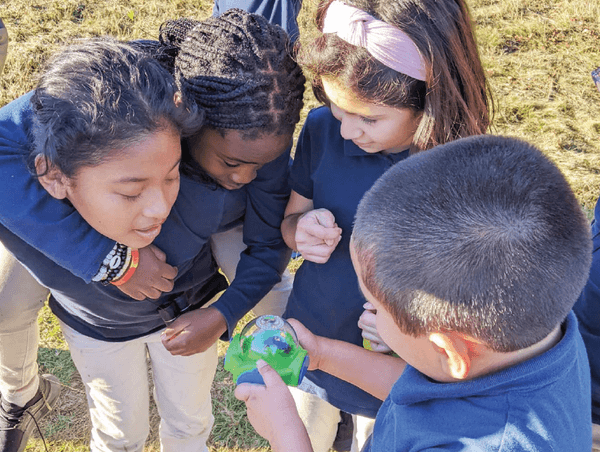
Students from the Paul Cuffee School in Providence examining a grasshopper in a magnifying bug box at the Caratunk Wildlife Refuge.
Every donor is different, and whether through binoculars, eyeglasses or a magnifying glass, people see wildlife through their own specific lenses. Throughout the year Hall and his staff work tirelessly to pair donors and their particular passion or concerns with its programs, initiatives, conservation work, stewardship, needs and visions. That also includes educating them on ways to give.
It is a never-ending process. In fact, forty-three percent of giving occurs in the last weeks of December. Hall also talks about Audubon’s reliance on endowment (“It saved us during the Great Recession”), and about stewardship for the future. The “hidden treasures” of Caratunk need to be available long after nature walks in September of 2023. What also matters is how that knowledge will be used. “Children grow up, and they are the future. They keep learning and passing it along.” Hall wants those Caratunk kindergarteners and summer campers to be returning one day with their own children for nature walks.
“Audubon is here today because people cared about nature and remembered us in their will,” he says. “Bequests fund the future forever.” When, through donor support of any kind, Audubon can fulfill its mission of educating five-year-olds about the wonders of wildlife, managing habitat for declining pollinator species, or permanently protecting forests, fields, and wetlands, it is connecting its founding legacy to what lies ahead.
And the future comes calling every day.
Betsy Sherman Walker is a Rhode Island native who writes for area non-profits, news, and lifestyle publications, and who has recently discovered the joy and wonder of birding. Touch base at walkerbets@gmail.com

















